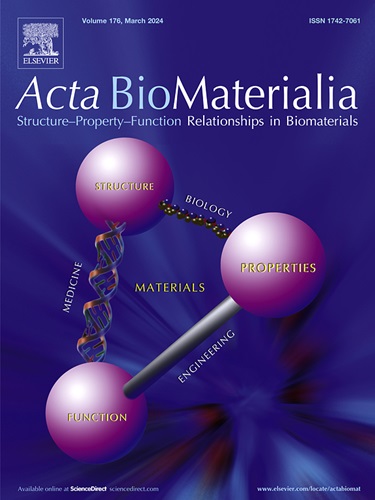Ribbon-like hypomineralization in human dental enamel
IF 9.4
1区 医学
Q1 ENGINEERING, BIOMEDICAL
引用次数: 0
Abstract
Human dental enamel is a uniquely hard and tough biological realization of the inherently brittle apatite crystal. In sound enamel both structure and chemistry are organically fine-tuned, while developmental disorders - such as hypomineralization - often lead to severe enamel alterations resulting in weaker mechanical performance and shorter lifetime as in case of molar-incisor hypomineralization (MIH) which has a global prevalence of 13.5 %. However, causes of the development of hypomineralization disorder remain unclear up to date. In the present paper, a new form of dental hypomineralization is reported for the first time. Structural and chemical alterations of dental enamel exhibiting a special ribbon-like hypomineralization (RLH) are compared to the characteristics of sound and MIH-affected teeth. Microporosity, mineral density and characteristic 3D macroscopic shape of the RLH affected volumes were captured by micro-CT analysis. On the submicron-scale, nanoporosity, unusual morphologies and reduced size of apatite nanocrystals have been revealed. These RLH specific features are coupled with a particular chemical fingerprint in Raman spectroscopy, which allows its clear separation from MIH affected and sound enamel. Based on these nanostructural features we conclude different failure mechanisms in the biochemical control during crystallization of the RLH and MIH enamel.
Statement of significance
Molar-incisor hypomineralization (MIH) is a developmental enamel disorder with up to 14 % prevalence, characterized by reduced mineral content, hypersensitivity, and post-eruptive enamel breakdown. The causes of the development of this disorder remain unclear up to date. In this study, we examine molars with hypomineralization in a ribbon-like macroscopic morphology. These molars show increased porosity, organic content, and reduced mineral content, while carbonate levels remain unchanged in both affected and unaffected areas, unlike MIH-affected enamel. Ribbon-like hypomineralized (RLH) enamel also features unusual apatite nanocrystal morphologies, including isometric crystals in the prism boundary zone and bean-shaped crystals with a soft central zone. Nanoscale analysis reveals RLH as a developmental anomaly distinct from MIH, offering novel insights into the biochemical controls of hypomineralization.

人类牙釉质带状低矿化。
人类牙釉质是一种独特的硬而坚韧的生物实现固有的脆性磷灰石晶体。在健全的牙釉质中,结构和化学都是有机微调的,而发育障碍-如低矿化-通常会导致严重的牙釉质改变,导致机械性能较弱,寿命较短,例如臼齿-切牙低矿化(MIH),全球患病率为13.5%。然而,低矿化障碍发展的原因至今仍不清楚。本文首次报道了一种新的牙齿低矿化现象。牙釉质的结构和化学变化表现出一种特殊的带状低矿化(RLH),与声音和mih影响牙齿的特征进行了比较。显微ct分析捕获了RLH影响体的微孔隙度、矿物密度和特征三维宏观形状。在亚微米尺度上,发现了磷灰石纳米晶体的纳米多孔性、不同寻常的形貌和缩小的尺寸。这些RLH特征与拉曼光谱中的特定化学指纹相结合,使其能够与MIH影响的珐琅质和健全的珐琅质清晰分离。基于这些纳米结构特征,我们得出了RLH和MIH牙釉质结晶过程中生化控制的不同失效机制。意义声明:磨牙-切牙低矿化(MIH)是一种发展性牙釉质障碍,患病率高达14%,其特征是矿物质含量降低、过敏和出牙后牙釉质破裂。这种疾病发展的原因至今仍不清楚。在这项研究中,我们检查了具有带状宏观形态的低矿化磨牙。这些磨牙的孔隙度增加,有机物含量增加,矿物质含量减少,而与mih影响的牙釉质不同,受影响和未受影响的牙釉质中碳酸盐含量保持不变。带状低矿化(RLH)牙釉质还具有不同寻常的磷灰石纳米晶体形态,包括棱柱边界区域的等距晶体和具有柔软中心区的豆状晶体。纳米尺度分析显示RLH是一种不同于MIH的发育异常,为低矿化的生化控制提供了新的见解。
本文章由计算机程序翻译,如有差异,请以英文原文为准。
求助全文
约1分钟内获得全文
求助全文
来源期刊

Acta Biomaterialia
工程技术-材料科学:生物材料
CiteScore
16.80
自引率
3.10%
发文量
776
审稿时长
30 days
期刊介绍:
Acta Biomaterialia is a monthly peer-reviewed scientific journal published by Elsevier. The journal was established in January 2005. The editor-in-chief is W.R. Wagner (University of Pittsburgh). The journal covers research in biomaterials science, including the interrelationship of biomaterial structure and function from macroscale to nanoscale. Topical coverage includes biomedical and biocompatible materials.
 求助内容:
求助内容: 应助结果提醒方式:
应助结果提醒方式:


